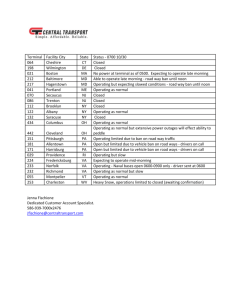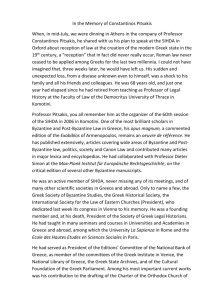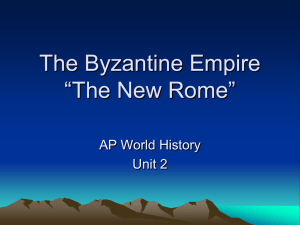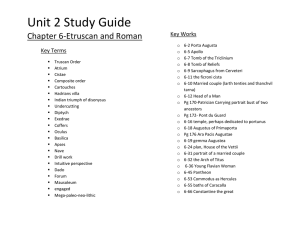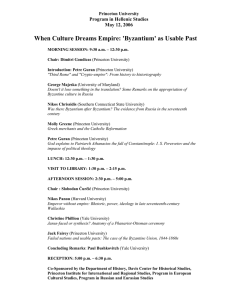Chapter 12 Glossary
advertisement
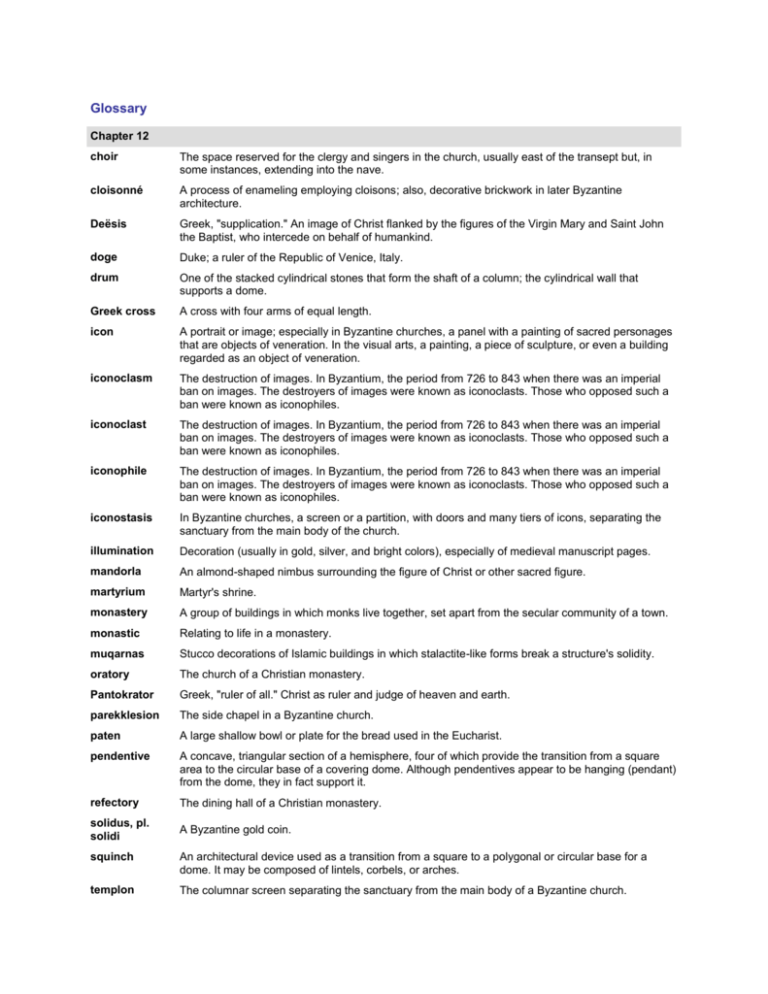
Glossary Chapter 12 choir The space reserved for the clergy and singers in the church, usually east of the transept but, in some instances, extending into the nave. cloisonné A process of enameling employing cloisons; also, decorative brickwork in later Byzantine architecture. Deësis Greek, "supplication." An image of Christ flanked by the figures of the Virgin Mary and Saint John the Baptist, who intercede on behalf of humankind. doge Duke; a ruler of the Republic of Venice, Italy. drum One of the stacked cylindrical stones that form the shaft of a column; the cylindrical wall that supports a dome. Greek cross A cross with four arms of equal length. icon A portrait or image; especially in Byzantine churches, a panel with a painting of sacred personages that are objects of veneration. In the visual arts, a painting, a piece of sculpture, or even a building regarded as an object of veneration. iconoclasm The destruction of images. In Byzantium, the period from 726 to 843 when there was an imperial ban on images. The destroyers of images were known as iconoclasts. Those who opposed such a ban were known as iconophiles. iconoclast The destruction of images. In Byzantium, the period from 726 to 843 when there was an imperial ban on images. The destroyers of images were known as iconoclasts. Those who opposed such a ban were known as iconophiles. iconophile The destruction of images. In Byzantium, the period from 726 to 843 when there was an imperial ban on images. The destroyers of images were known as iconoclasts. Those who opposed such a ban were known as iconophiles. iconostasis In Byzantine churches, a screen or a partition, with doors and many tiers of icons, separating the sanctuary from the main body of the church. illumination Decoration (usually in gold, silver, and bright colors), especially of medieval manuscript pages. mandorla An almond-shaped nimbus surrounding the figure of Christ or other sacred figure. martyrium Martyr's shrine. monastery A group of buildings in which monks live together, set apart from the secular community of a town. monastic Relating to life in a monastery. muqarnas Stucco decorations of Islamic buildings in which stalactite-like forms break a structure's solidity. oratory The church of a Christian monastery. Pantokrator Greek, "ruler of all." Christ as ruler and judge of heaven and earth. parekklesion The side chapel in a Byzantine church. paten A large shallow bowl or plate for the bread used in the Eucharist. pendentive A concave, triangular section of a hemisphere, four of which provide the transition from a square area to the circular base of a covering dome. Although pendentives appear to be hanging (pendant) from the dome, they in fact support it. refectory The dining hall of a Christian monastery. solidus, pl. solidi A Byzantine gold coin. squinch An architectural device used as a transition from a square to a polygonal or circular base for a dome. It may be composed of lintels, corbels, or arches. templon The columnar screen separating the sanctuary from the main body of a Byzantine church. Theotokos Greek, "she who bore God." The Virgin Mary, the mother of Jesus. triptych A three-paneled painting, ivory plaque, or altarpiece. Also, a small, portable shrine with hinged wings used for private devotion.






